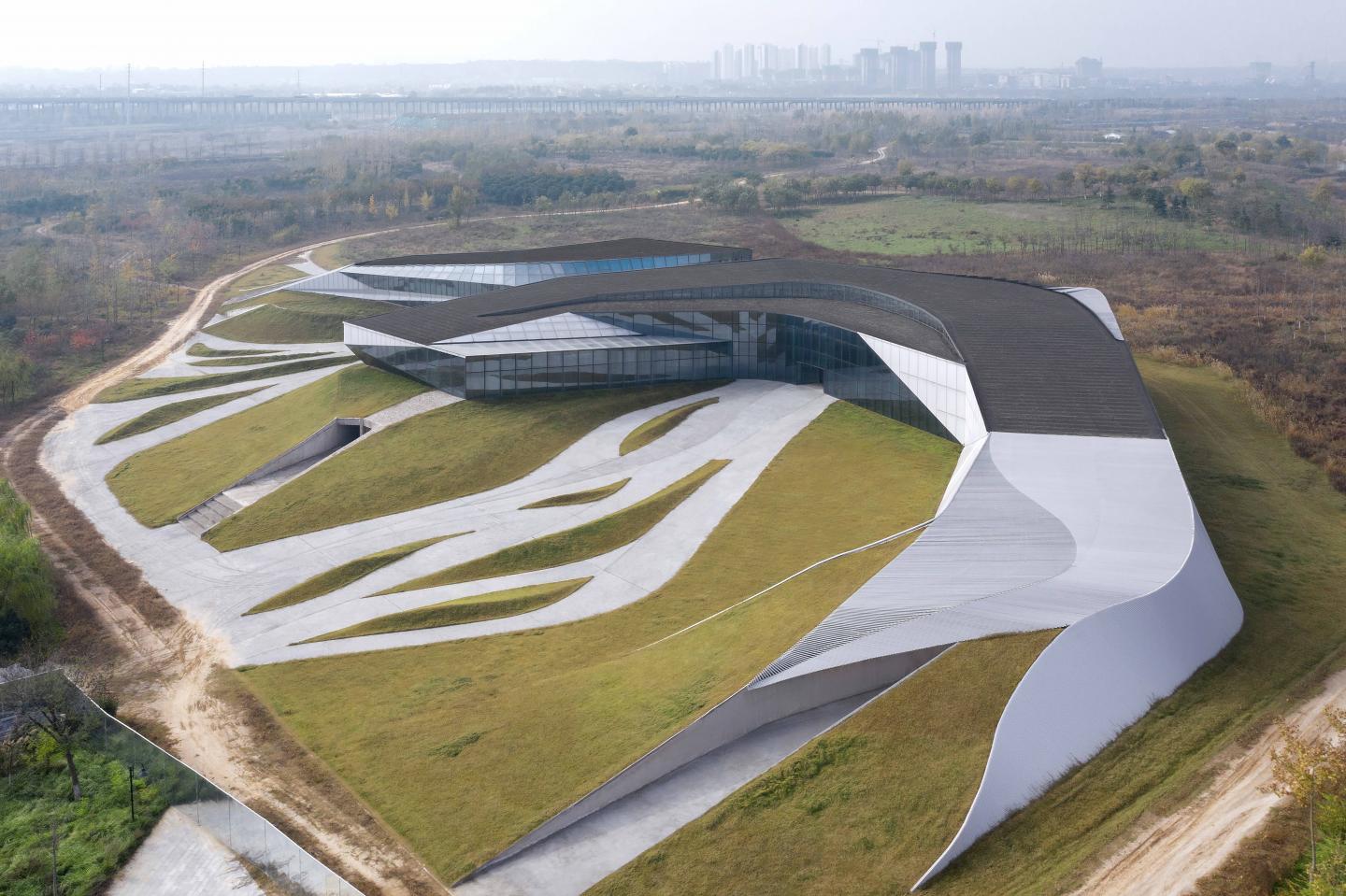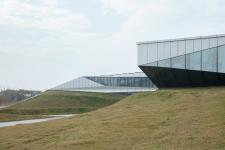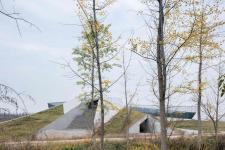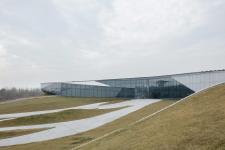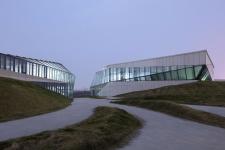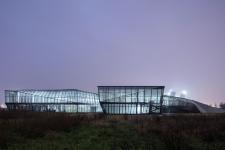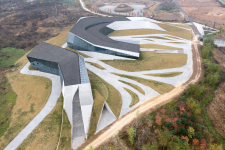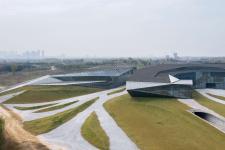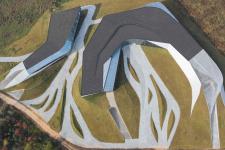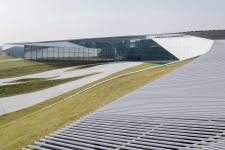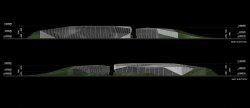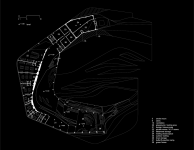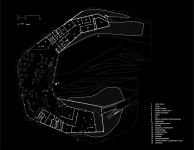Xi'an Eco-Park is part of the ecological park located in the Chongwen Jing River region of Xixian New Area. The project includes an eco-restaurant and a design hotel, acting as a focal and start-up point within the landscape. Based on the integrity of the design and the compatibility with the surrounding environment, we waving the architecture and landscape together, a spatial twist and the mutual transformation between architectural and landscape become the main design concept. To achieve this symbiotic relationship, our main concern was to develop a language compatible with the landscape, such that the architectural event takes place as a consolidation or intensification of a (various) moment(s) within the park.
The design, hence, is triggered by the desire of building, a dialogue between the landscape and its architecture, and an exchange that can build local specificity generating a sense of strong identity. Such identity, however, instead of relying on iconoclastic imaginary, finds its articulation in its placing within the site, stretching its boundaries onto the ground and producing a woven linkage with the landscape through elongated transitions – both spatial and functionally, it (re)defines its context and creates a new environment.
Through the thinking of the integration and landmark of the buildings, the site information and the target benefit are organized organically, so that the design itself skillfully transforms back and forward in the dialogue between the landscape and the architecture, and then produces a compound product that transforms mutually in space and function, giving the site a new feature.
Accompanied by its own vegetable and fruit planting park as well as butterfly greenhouse, the restaurant has the same concept orientation as the whole park, focusing on ecological simple meals and emphasizing the production and processing of Xi'an's local ingredients. The experience offered to dinners includes picking their own vegetables and following its cooking process. In addition to the dining experience, the project proposes some auxiliary activities such as a children playground and a greenhouse, both included in the internal layout of the restaurant. As a supporting part of the restaurant, the design hotel only has 17 guest rooms, each of which has a high-quality landscape orientation and is connected to each other by an intensive two-story reception area.
Morphologically speaking, the building grows from the topography at the north, evolving into a sinuous body that splits creating a gap for natural light and a vertiginous volumetric drop at the entrance plaza. Toward the south, it sits onto an artificial higher elevation, hence allowing for a series of interior spaces (children playground and greenhouse) that play with the slopes through some slanted surfaces, among which we locate the main access ramp to the upper floor. The butterfly house is located on the south outer ring of the restaurant. With the comparison of the continuity on the north side, the butterfly house is inserted into the building as a glass case that brings the landscape indoors. At the same time, a series of spaces are generated as an integrated body that interweaves the landscape, the playground and the two main floors of the restaurant. As we introduce part of the terrain into the interior space, the indoor "hill" has become the focus the design. According to the passageway hidden under the hill, the diners can entry the interior space and experience an exploratory while visiting the park. After passing through the semi-underground path, it suddenly becomes spacious and then turns to enter the indoor activity space.
The design hotel is located on the north side of the restaurant in a way that is similar to mirror rotating. Unlike the ecological restaurant, the continuous blocks are opened from the outside elevation to forming the open balcony of the rooms. Besides, the curve of the roof is naturally shaped into a zigzag triangle resulting from the stronger twist. In this part, the landscape is no longer been brought into the interior, but more like an envelope trying to wrap the entire building foundation. Such functions and their distinctive spatial requirements—both layout and materiality—are woven into the two ribbon like bodies converging by the entrance.
Diagrammatically speaking, the building is a major arc with both of its end points at the lowest elevation (+0.00m) and its middle point at the highest elevation (+4.80m). The three-dimensional spatial distribution resembles an ascendant spiral movement which is actualized by a membrane that more than covering/enclosing the internal area of this arc, augments the rich plasticity of the diagram as such. On the north side, at one of the endpoints, this roof is generated by 5 curves that bifurcate from lines coming out of the surrounding topography. These curves run along various elevations, working as a veritable extension of the ground to the roof of the building showcasing striations and depressions—topographic features in themselves. At the south side, at the other end point, two of the controlling curves of the roof drop dramatically reaching the ground, while the other remaining curves stay at a higher elevation, the green space flowing out with the bottom reflects the ecological nature of the project.
2017
2019
Typology: Restaurants, hotels, landscape architecture
Status: Completed
Building Area: 6500 m²
Local Design Institute: Huachengboyuan(Beijing)Architecture Design & Urban Planning co. LTD
Contractors: Shannxi Construction Engineering Group Company LTD.
Photography: Xiazhi
Architect: Plasma Studio, PMA (PolyMorphArchitects)
Principal in Charge: Eva Castro, Chuan Wang, Holger Kehne, Ulla Hell
Project Team: Libny Pacheco,Pietro Scarpa,Pingshan Qu,Xiaoyu Zhang,Yan Xue,Marco Dambrogio, Cesare Zilio (Architecture Design); Wenxuan Qiao,Yujun Zou,Sheng Jing,Bo Jing,Ya You (Lanscape Design)
Favorited 1 times
